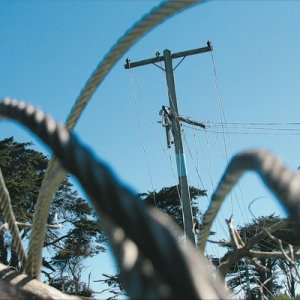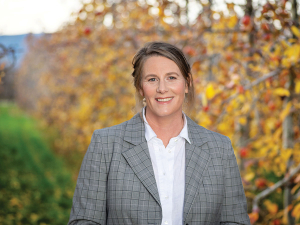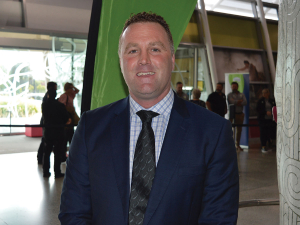FROM WANGANUI onwards the signs of the storm are visible as you drive up State Highway 3. But beyond Waverley, the damage to farms is more obvious and clearly the Patea area is the worst affected.
The epicenter of the storm appeared to be the tiny township of Kakaramea, just north of Patea. It’s a significant dairy farming area and the worst-hit.
Driving down Wilson Rd just a few kilometres from Kakaramea, the massive trees that have been cut to clear the road, the tangled power lines and broken power poles are a stark testament to the incredible strength of the gale force winds. It’ll be several days before the power is back on here.
In the paddocks hay bales stand alone, while up to 300m away sheets of roofing iron that used to cover the hay are scattered around the fields, some even wedged in clumps of broken trees. Amazingly, few houses are badly damaged. The cows graze quietly and patiently - waiting to be milked and oblivious to the linesman desperately trying to restore power and farmers firing up or trying to buy or hire generators to run the sheds and pump out stock water.
David Werder has lived in the district for 35 years and like others have never witnessed anything like the ferocity of the winds that hit that fateful Saturday morning. Winds started to get up about 4.30am just as he was about start milking and by 6.30am it was all over and the damage done.
The power was out at 5.40am “then action plans swung into place to try and get generators sorted to get everything moving,” he says. “We have ended up milking four sheds using one generator, so we have been going from three in the morning to midnight.”
Werder and another farmer bought a generator which is powered by the power take off (PTO) of a tractor. They have been sharing it with two other farmers in the area. All have been milking twice a day but not at the normal scheduled times.
Werder was number two on the list and was milking at 5am.
This disaster and the resulting power outage looked like continuing for almost a week, again highlighted the need for dairy farmers to have a generator or, at worst, be a part of a group that shared one.
Dairy News spoke to one farmer who’d only managed to get a generator on Monday afternoon and that evening would be his first milking since the power went out.
In the case of Werder and his fellow farmers, they took the generator from farm to farm to get the job done as quickly as possible. Community spirit in Kakaramea is strong and supportive.
Werder milks 340 cows on his property and says the damage to his farm has meant production will fall as he is unable to feed out as much supplement as he should because of a water shortage.
He has been so busy he hasn’t even bothered to look at production.
Getting sufficient water is a huge problem for dairy farmers. Werder and his fellow farmers were sharing a generator for milking, but all still needed power to pump water for stock. While I was on his farm, Werder managed to get a Fonterra tanker to deliver water. He had also just bought a new generator which was turning up on the Monday night and this would probably see him through until the power was restored later in the week.
“It’s only a small single-phase generator so I can run the water pump,” he says.
Water is a big issue for Waverley dairy farmer Warwick Lupton. He says if cows can’t get water they’ll “go mad” and run through fences to get it.
But Lupton has other issues as well. He’s busy supervising repairs to a dairy shed on one his farms. He wasn’t there when the storm hit. He was racing boats on Lake Karapiro when he got the call at 5.30am on Saturday.
“It actually got that dangerous that we couldn’t even send the staff outside because they physically couldn’t stand up in the yard,” he says. “It was hard to believe but one female staff member got pinned down on the concrete and they had drag her in – that’s how vicious the winds were. I’ve been here all my life and I’ve never heard or seen anything like this. It was lucky that no one was hurt.”
The damage to his dairy shed was substantial. “It took the whole side of the shed out. It took all our chiller units and our gas out and took the electricity out as well. It’s built out of freezer panel and just took a whole panel out and tossed it out across the farm.”
Loss of power for Lupton meant no milking and no water for the cows. Lupton was quick off the mark hiring generators and bringing them in from as far away as Wellington and Wanganui.
With his shed too badly damaged to milk, even with a generator, Lupton had to move his cows from this farm to another he owns nearby.
“If you’re winter milking like we are, a lot of the cows are calving now and if you do damage to them you’re hurt for the rest of the season. If you don’t treat cows well you can quickly lose production and never get it back,” he says.
He says another challenge with a dairy shed out of action is managing that herd and making sure all the farms don’t suffer.
“Obviously it ruins the feed pattern for the farm so we have got to tie them up really really tight and just cart silage from this farm so we don’t bugger up their pattern for the winter,” he says. “Because if they chew that out, the other herd is in severe trouble, it takes a bit of organising to get things right. If you haven’t got a plan you’ve got a problem.”
Back at Kakaramea, Werder who’s a Fonterra Shareholders Council member, has been trying to arrange for Fonterra to do more frequent pickups of milk from those farmers without continuous access to a generator to keep the milk cool. In some cases farmers are disposing of milk because they can’t keep it cool enough for pickup.
The damage caused in space of just a couple of hours has to be seen to be believed.
As well as damage to shed and power and phone lines, maize crops have been badly – some completely flattened and stalks broken.
The cost of this fast ferocious storm is hard to estimate. There will be production losses, infrastructure losses such as shed and hay barns, but probably the biggest cost will be the time and effort required to repair fences and clean up the mess.
















